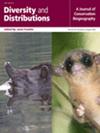Shifting Gears in a Shifting Climate: Birds Adjust Migration Speed in Response to Spring Vegetation Green-Up
Abstract
Aim
Investigate whether birds use vegetation green-up, a measure of spring arrival, as a cue to shift their migration speed in response to climate change by examining: (1) how green-up moves in the landscape, (2) how bird migratory speed responds to green-up, (3) how species traits affect migratory speed and (4) how migration speed affects arrival time at breeding sites.
Location
Eastern North America.
Time Period
2002 to 2017.
Major Taxa Studied
Fifty-five species of eastern North American Passerines.
Methods
We calculated speed at the migration front using arrival dates derived from 16 years of eBird data with a linear regression. Similarly, we calculated the advancement speed of forest vegetation green-up using satellite data. Green-up effects on bird speed were tested using generalised additive models.
Results
On average, songbirds migrate northward during spring at a mean speed of 63 km/day. We observed strong non-linear effects of latitude, with bird migration speed accelerated and green-up speed slowed as the distance from the equator increased. Annual and spatial variation in bird migration speed depended on the local green-up date and how quickly green-up was advancing northward: years with earlier and faster green-up were associated with higher migration speeds. Bird arrival relative to green-up was strongly influenced by two variables: how early green-up was and how fast birds were migrating.
Main Conclusions
The variation of bird migration speed with green-up suggests birds can shift migration speed to ‘catch up’ with earlier springs. However, the stronger effect of green-up date compared to migration speed suggests that birds do not fully compensate for arrival time by simply migrating more quickly. Climate change will likely outpace birds' ability to speed up their migration and adapt to new phenological regimes.


 求助内容:
求助内容: 应助结果提醒方式:
应助结果提醒方式:


